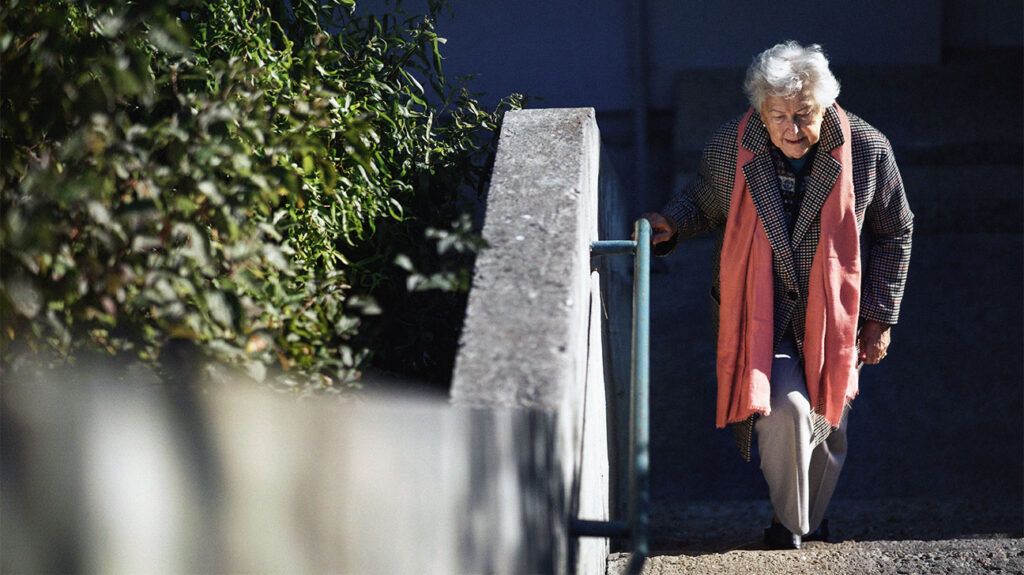Proprioception is the body’s ability to sense its position, movement, and orientation in space. People with dementia experience brain changes that can lead to issues with proprioception.
Proprioception is pivotal in daily activities such as sitting, walking, and maintaining balance. It is the sense that enables a person to touch their nose with their eyes closed.
As individuals develop dementia, they can experience a decline in proprioceptive function. These alterations may affect their ability to navigate space and coordinate movements.
Continue reading to learn more about proprioception in dementia, its signs, and potential treatments.

Proprioception
In dementia, changes in the brain’s function can disrupt proprioception.
Dementia is a condition that causes the
The brain regions responsible for processing proprioceptive information may become damaged or shrink during the disease, affecting the transmission and interpretation of signals related to body position and movement.
This interference manifests as a decline in proprioceptive function, presenting several challenges for individuals with dementia. For example, they may not know where parts of their body are or overshoot or undershoot movements.
However, not everyone with dementia experiences the same changes to proprioception, nor will they experience them at the same stage of the disease. A
As a result, the way in which proprioception changes in dementia may vary from person to person. Some may retain aspects of proprioception late into the disease.
It is critical to recognize the signs of proprioception issues in individuals with dementia to allow for appropriate care and support.
- difficulty maintaining balance
- unsteady or shuffling walk
- changes to gait
- challenges in reaching or grasping objects accurately
- difficulty making precise movements
- increased risk of stumbling or falling
- struggles with dressing or feeding
Proprioception changes in dementia lead to complications that significantly affect the daily life and well-being of affected individuals.
A significant issue is an
A person may also experience impaired mobility, affecting their ability to move freely and confidently, leading to reduced physical activity and autonomy.
While there is no cure for the underlying processes that cause dementia, several interventions may help. They include:
- Physical exercise and rehabilitation: Balance exercises, strength training, and activities focusing on coordination and spatial awareness may help support motor control.
- Occupational therapy: Occupational therapists work on developing strategies to prolong independence in daily activities for those with dementia. This may include adapting a person’s environment, teaching them to use assistive devices and equipment, or changing their routine.
- Medications: While no medication can restore proprioception in dementia, doctors
may prescribe certain drugs, such as galantamine or donepezil (Aricept), to manage some of the symptoms of cognitive decline. However, these drugs can cause side effects, so it is important to weigh the risks and benefits with a doctor.
Proactive measures may help minimize the injury risks of proprioception changes and facilitate ease of movement. Caregivers can try:
- Removing hazards: Create a clutter-free environment by removing tripping hazards, loose rugs, and unnecessary furniture. A clear, unobstructed space reduces the risk of falls.
- Enhancing lighting: Ensure the home has good lighting, especially in commonly used spaces and pathways. Adequate lighting helps individuals better perceive their surroundings and reduces confusion.
- Using supportive devices: In bathrooms and hallways, install handrails and grab bars to provide additional support and stability.
- Using mobility aids: Depending on the individual’s needs, consider using walking aids such as canes or walkers to enhance stability during movement.
- Structuring the daily routine: Establish a consistent daily routine, including regular meal times and activities. Predictability fosters a sense of security and helps individuals anticipate movements.
- Using simple instructions: Provide clear and simple instructions when assisting with movements. Break down tasks into manageable steps to help the person understand.
Proprioception is the body’s ability to sense its own position, movement, and spatial orientation. In dementia, neurogenerative changes and cognitive decline lead to issues with proprioception.
As a result, people with dementia may have altered gaits, difficulty reaching for and grasping items, and challenges with daily living tasks. This increases the risk of falls and injuries.
While no cure for dementia exists, treatments such as exercises and physical rehabilitation may enhance proprioception. Doctors may also prescribe certain medications to help manage some of the symptoms.
Furthermore, changes to the home, alterations to routine, and clear communication may help keep people with dementia safe and allow them to remain independent for longer.
